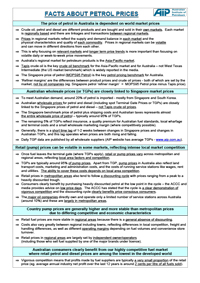Facts About Petrol Prices
Publication date
08 Sep 2017
Resource Type
Description
The price of petrol in Australia is dependent on world market prices
- Crude oil, petrol and diesel are bought and sold in their own markets. Each market is regionally based and there are linkages and transactions between regional markets.
- Prices in regional markets reflect the supply and demand balance in each market and the physical characteristics and quality of each commodity. Prices in regional markets can be volatile and can move in different directions from each other.
- This is why focusing on relevant markets and longer term price trends is more important than focusing on volatile daily or week-to-week price movements.
- Australia's regional market for petroleum products is the Asia-Pacific market.
- Key crude oil pricing benchmarks for the Asia-Pacific market including Australia are Tapis, Dated Brent and Dubai – not West Texas Intermediate (the US market benchmark) widely reported in the media.
- The Singapore price of unleaded petrol (MOPS95 Petrol) is the key petrol pricing benchmarkfor Australia.
- 'Refiner margins' are the differences between product prices and crude oil prices, both of which are set by the market, not by oil companies (eg. Singapore petrol 'refiner margin' = MOPS95 Petrol price minus the relevant crude oil price).
Australian wholesale prices (or TGPs) are closely linked to Singapore market prices
- To meet Australian demand, around 20% of petrol is imported – mostly from Singapore and South Korea.
- Australian wholesale prices for petrol and diesel (including spot Terminal Gate Prices or TGPs) are closely linked to the Singapore prices of petrol and diesel – not to crude oil prices.
- The Singapore benchmark price of petrol plus shipping costs and Australian taxes represents almost the entire wholesale price of petrol – typically around 95% of TGPs.
- The remaining 5% of TGPs reflect insurance, a quality premium for Australian fuel standards, local wharfage and terminal costs and a small wholesale marketing margin (where competitively possible).
- Generally, there is a short time lag of 1-2 weeks between changes in Singapore prices and changes in Australian TGPs, and this lag operates when prices are both rising and falling.
- Daily TGP data are published by all wholesale suppliers (AIP website has average TGPs – www.aip.com.au).
Retail (pump) prices can be volatile in some markets, reflecting intense local market competition
- Once fuel leaves the terminal gate (where TGPs apply), retail or pump prices vary across metropolitan and regional areas, reflecting local area factors and competition.
- TGPs are typically around 95% of pump prices. Apart from TGP, pump prices in Australia also reflect land transport costs, marketing and administration costs, and the costs of running service stations like wages, rent and utilities. The ability to cover these costs depends on local area competition.
- Retail prices in metropolitan areas also tend to follow a discounting cycle with prices ranging from a peak to a heavily discounted trough.
- Consumers clearly benefit by purchasing heavily discounted petrol at the low point in the cycle – the ACCC and media provides advice on low price days. The ACCC has stated that the cycle is a clear demonstration of vigorous competition and the discounting cycle clearly benefits price conscious consumers.
- The major oil companies directly own and operate only a limited number of service stations across Australia (around 10%) and these are largely in metropolitan areas.
Country pump prices are generally higher and more stable than metropolitan prices due to differing competitive and economic characteristics
- Retail fuel prices are more stable in regional areas because there is a general absence of discounting.
- Costs also vary greatly between regional towns, reflecting differences in local competition, freight and handling differences, as well as different operating margins depending on fuel volumes and convenience store turnover.
- Retail prices in regional areas are largely set by independent owner/operators (including those who sell fuel supplied by one of the major brands under licence).
Australian consumers clearly benefit from our highly competitive fuel market where retail petrol and diesel prices are among the lowest in the developed world
- Vigorous competition means that profits made by fuel suppliers are typically a very small proportion of the retail price (eg. average annual industry net profit over the last 12 years is around 2 cents per litre of all fuels sold).
